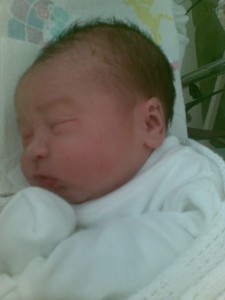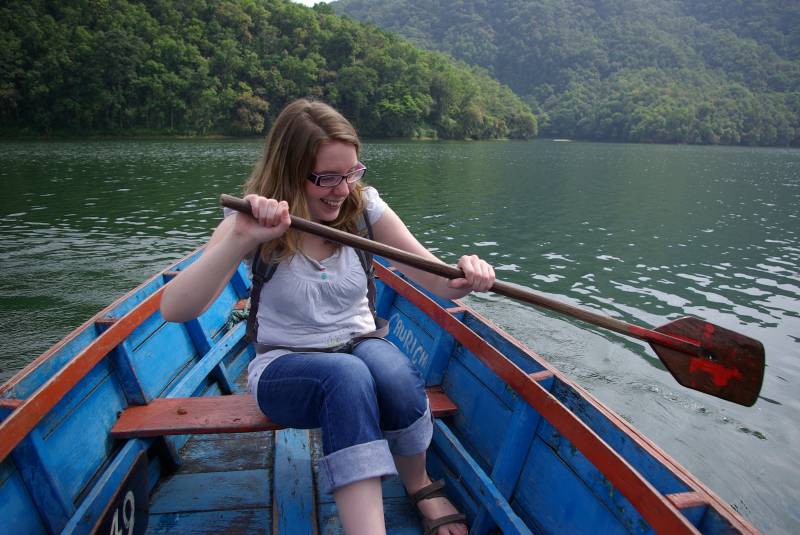
Edel rowing on the Phewa Tal lake by Pokhara.
Pokhara in Nepal is described as a great place to relax after a long hard trek or any time spent in India, and it is. At 800 meters altitude it’s pleasantly cool, and it’s been on the backpacker trail so long there’s apple pie on every menu. It wasn’t too difficult to get here from Varanasi, one day in a jeep to leave India and one day on the bus to climb the Nepali hills. We’d bought a combined ticket for the whole way in Varanasi, which would include one nights accommodation in the little border town of Sunauli, but considering our success with tourist buses so far we only really expected the first leg of the journey to actually materialize – if we’d make it as far as the border we’d be happy. When they told us in the morning that the bus for the first day had been swapped for a jeep because there were only 14 tourists traveling that day Edel was placing all bets on them planning to cram all 14 of us into a standard 4-seater, but when the jeep arrived things looked slightly better. It could probably fit 11 people comfortably, 14 rather uncomfortably or about 60 Indian-style (14 people I’m sure we’ve seen emerge from a single tuktuk). 9 bouncy hard-seat hours later we were in Sunauli (the hostel was pretty dirty even by Indian standards but we did get our own room+bathroom), and in the morning after sorting our the border formalities we were landed on a public bus to Pokhara. I made a good friend on the bus, and older woman who was sitting next to us (an extra row of seats filled the aisle) kept talking to me even though we didn’t share a common language. We still managed to crack some jokes using mostly sign language, about our shared hope that the race-car driver wouldn’t send us crashing into the ravine, and about the drunk sleeping on my shoulder..
Like clockwork at the start of our third month traveling I got my third round of fever and dysentery. Since arriving in Pokhara a few days earlier I had put myself on a healthy diet of mostly chocolate brownies and ice-cream, so I suspect it must have been a good-bye present from India.. Once cured we lazed around a number of days in Pokhara, before organizing a 10-day trek in the Annapurna mountain range together with a guide and a porter found through the guesthouse where we were staying. One of the days before setting off the Maoists were demonstrating in Pokhara – they were marching on the street and had ordered every business in town closed. One restaurant that still kept open in secret would only let us in through the door after first looking both ways outside, then opening the door only slightly so we could just barely squeeze in. We asked different people later about the demonstration, but most of them seemed a little edgy talking about it.
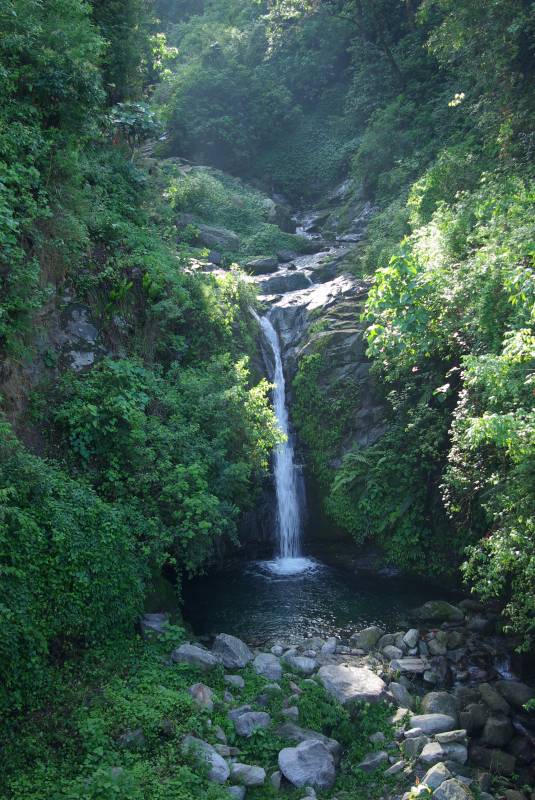
Waterfall near Thikhedhunga.
The Annapurna Sanctuary trek starts at about 1050 meter and climbs up to the Annapurna Base Camp at 4150 meter – the base camp is located in a hidden valley surrounded on all sides by mountains 6000-8000 meter high. Two of the peaks visible from the basecamp are over 8000 meter; Annapurna I at 8091m and Dhaulagiri at 8167m, ranked the 10th and 7th highest in the world. Annapurna I was actually the first of the worlds 14 eight-thousanders to be climbed, in 1950, and is still the most deadly claiming more than every third climber. Basecamp is of course perfectly safe to get to though, and the trek is a “tea-house trek”, meaning there are villages or little guest-houses along the way where you can stay without having to camp out. We’re timing this perfect for the season to be over – June here brings the monsoon with rains and leeches, but also empty trails and guest-houses and lots of wild-flowers. The first day was easy, sleeping in the village Thikhedhunga at 1500m after a 4 hour trek passing terraced rice fields and cute little villages on the way. On the second day we climbed another 1300 meter to Ghorephani at 2800m, passing more picturesque villages, Ulleri, Banthati, Nagathati, on the way. The first half was pretty hard, stone stair-cases the whole way up the mountain between the villages and no flat sections – higher up the landscape changed to forest, it got cooler and the climbing was less steep. The forest was gorgeous with the trees covered in moss, ferns and other epiphytes, and orchids in bloom on many of the branches.

Orchids in the Annapurna forest.
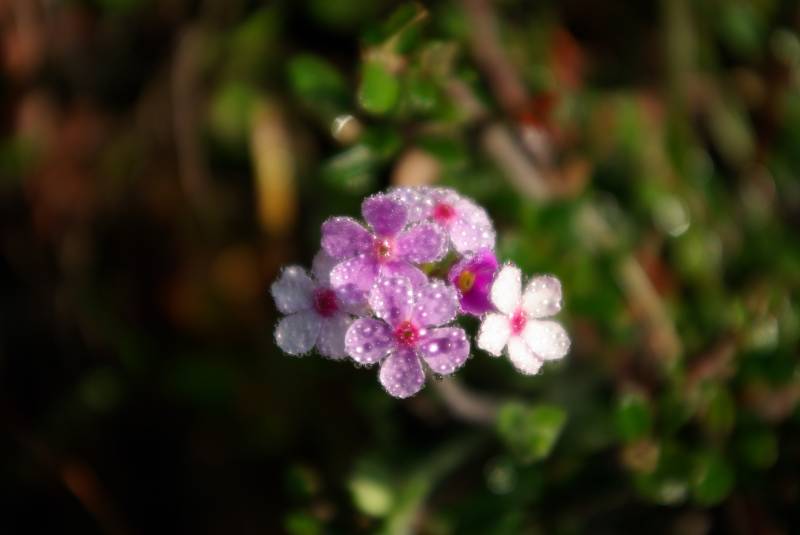
Wildflowers by Poon Hill.
Day three we started climbing at 4:30am, to get to the 3200 meter Poon Hill for sunrise (something that’s only 3200 meter high doesn’t get to be called a mountain in Nepal). There were about 12 other people hiking up the same morning, apparently it can be about 300 in high season..wouldn’t have wanted to climb the small viewing tower on top of the hill with a crowd that size. The sunrise was stunning, the rays of light slowly creeping over the 6993 meter Machhapuchhre (fish-tail) mountain in the distance. It sometimes gets clouded over in this season, so we felt very lucky to have perfect views. Down again to Ghorephani for breakfast, then up once more to 3200m in the other direction, then down to about 2500m before finally climbing up to the village Tadapani at 2700m. After the 2nd day we had felt great about the progress, having climbed 1.3 km up to 2800m there would only be another 1.3km climbing left to basecamp! But that’s not how trekking works around here – as the guides say “a little bit up, a little bit down” – during day 3 we had climbed over a kilometer but still ended up lower than when we started..and it wouldn’t be the last day like this as there were several deep river valleys to cross before we would get close to the hidden Annapurna Sanctuary valley and the basecamp. There were plenty of things along the way to make sure we enjoyed every step though – the walk across the hills to Tadapani had passed through some beautiful misty rhododendron forests.

Sunrise over Machhapuchhre (fishtail mountain) from Poon Hill.
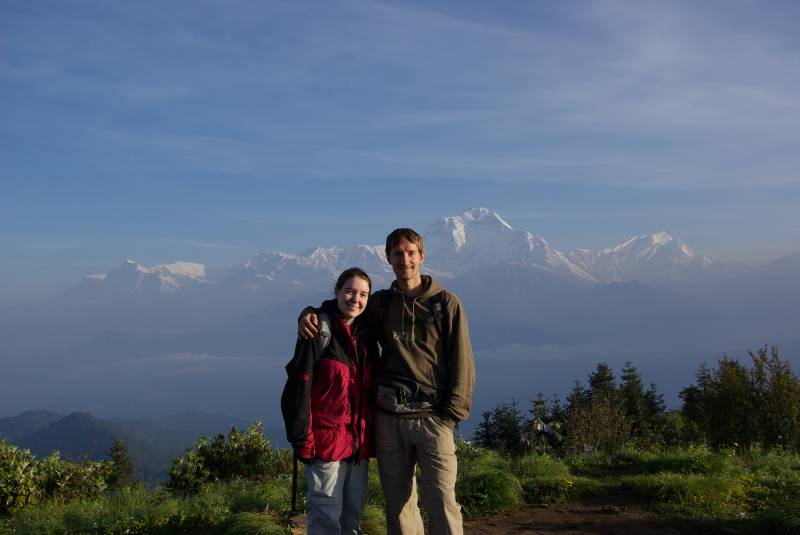
View towards Dhaulagiri from Poon Hill.
Day four of the trek was Edel’s birthday – we celebrated with chocolate and by taking the afternoon off after climbing half a kilometer 😀 We crossed a river at 1800m and slept in Chhomrong at 2200m. As we are lower down again the landscape had shifted back into rice fields and villages – forests usually only remain above 2500m. The 5th day we crossed another river below 2000m, passed the Sinuwa and Bamboo teahouses before climbing up to Dovan at 2600m. Here we were starting to get a bit further from civilization – no more villages, just tea houses set up for the trekkers, and everything has to be carried on the back of a porter for days to get here. We saw porters carrying big metal kegs of gas on their back, or one skillfully navigating the narrow paths with a pack of 4 meter long planks. Food and everything else naturally cost more up here – a hot shower is extra and cost more than the accommodation (if the water is gas-heated, some places have solar-heated). A room is usually just 1-3 euro/night though, as long as you have all your meals in the same teahouse.
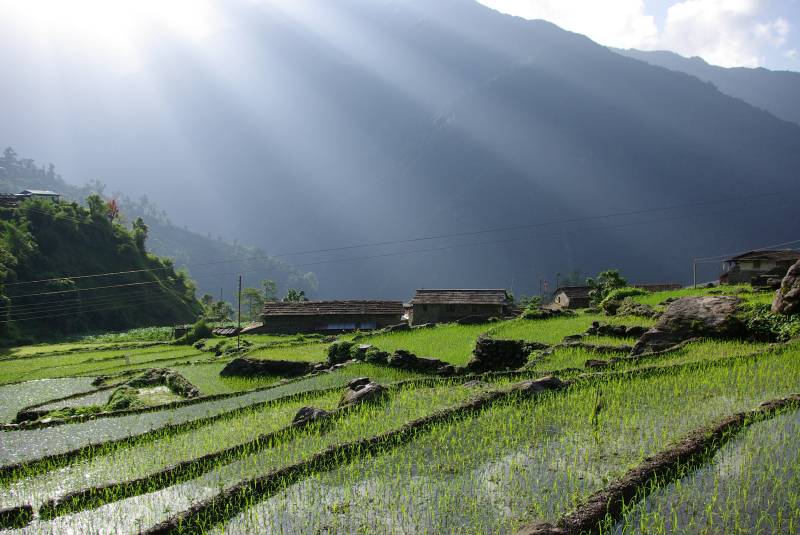
Rays of early morning light over the Chhomrong rice fields.

Edel crossing a bridge.
Day six we aimed to climb the final stretch up to the base camp, a 1.6km climb. We started at 6:30am with the first part of the walk passing through beautiful forests with views to the Annapurna and Machhapurchhe mountains in the distance as the valley closed in around us. On both sides were high steep forested mountain sides with waterfalls crashing down hundreds of meters. We had to cross a small glacier, and many tiny rickety looking bridges across little streams along the way. Past 3500m the landscape opened up completely, no more trees but plenty of wildflowers everywhere. We had lunch in the Machhapurchhe basecamp at 3700m before walking the final stretch to Annapurna basecamp – the landscape up here was even more barren..actually reminded a little of Connemara if it wasn’t for the 8000m mountains that jumped out of the clouds every now and then.
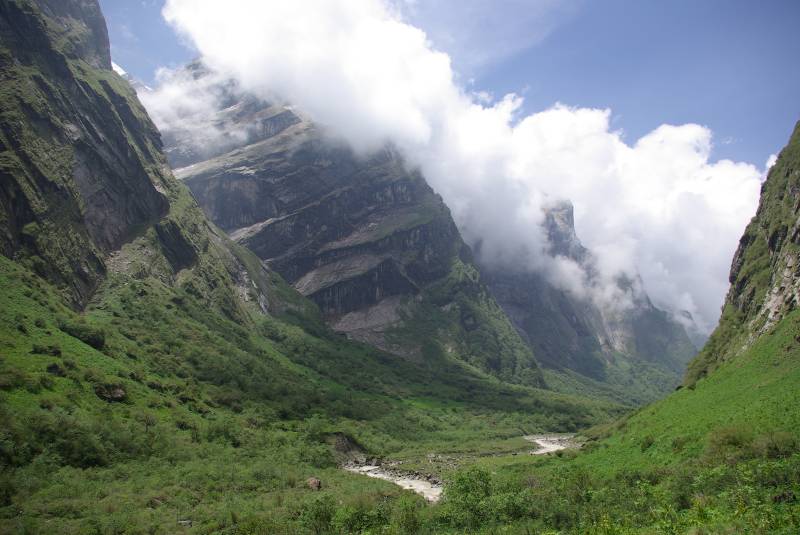
The Annapurna Sanctuary valley.

Wildflowers near basecamp.
We reached Annapurna basecamp after 8 hours of trekking – the last stretch felt quite long as we were tired and could see the camp in the distance but it never seemed to get closer. The final stretch crossed another glacier, quite flat and with lots of rocks and dirt on top so it wasn’t slippy, but we could hear the water gushing some meter below our feet and there were a few holes to watch out for. The basecamp sits right in the center of a circle of 6-8000 meter mountains, and the way we came in is the only route that doesn’t require climbing gear. The views are fantastic all around, mountains moving in and out of the clouds in the afternoon and evening and in the morning crystal clear views all around. We were up at sunrise to watch the views, after a night that wasn’t as cold as we’d feared at 4130m. Shower came in the form of a bucket of hot water for 2 dollars extra.

Cloudy evening view over the Annapurna range from basecamp.

Edel, Shiva and Deepak crossing a glacier.
Day seven we started the long walk down, reached the Bamboo teahouse after 8 hours just when the afternoon rains were starting. One of my knees were really killing me on the way down – down is much harder than up and takes a good toll on knees and feet. I adopted a walking stick for the first time, have always thought these are just an extra thing that you have to carry but this time I used one for support so much I got a blister in my hand. Edel was suffering a bit also, and we used our full supply of compeed to patch up her foot. When we were slow in the downhill sections our fantastic guide and porter, Shiva and Deepak, used the time to pick us fitsfulls of wild strawberries 😀 . At the Bamboo teahouse we got a small taste of what high-season must be like..in most of the places we stayed we were either alone or in nice company with just a couple other trekkers, but here a party of 12 arrived – mid-twenties teenagers who spent the whole night on drinking games, truth-or-dare, roaring, puking and throwing bottles around. Why bother going trekking if that’s all you want to do..instead of just going to sit on a nice beach in thailand where they could be with people who share their “interests”…? They’d arrived late in the afternoon, soaked in the rains that start every day around 2-4pm, probably after a late start due to hangovers from the day before…you create your own misery. I slept through most of it but they kept Edel and a nice Australian couple in the room next to us awake much of the night. We made sure not to be too quiet when we started before dawn the next day 🙂
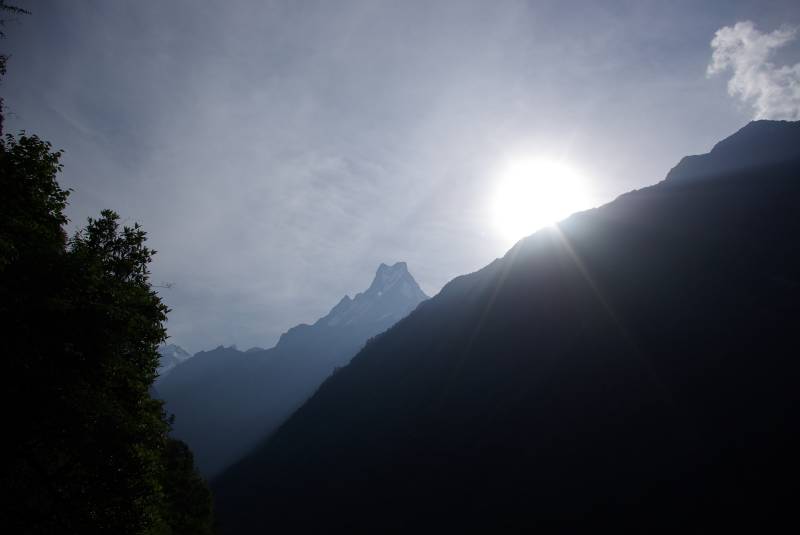
View along the trek from Bamboo to Sinuwa.
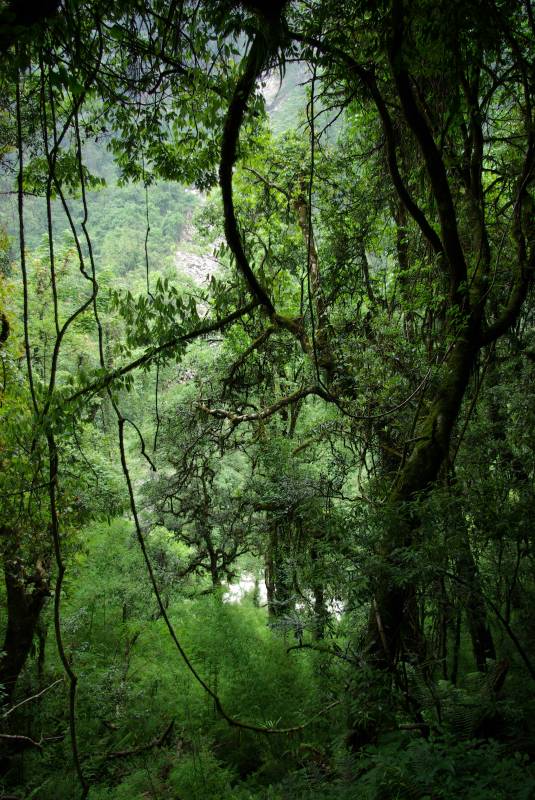
Forest in the Annapurna Sanctuary.
From Bamboo we continued backtracking past Sinuwa and Chhomrong then turned off to a village called Jhinu near some hotsprings..good for trekking-tired legs. The long stone stairs climbing up to Chhomrong after crossing the river 500m below were pretty hard as it was nearing midday and quite hot. Oddly enough our legs were in better shape than the day before though – good to be climbing a bit again after all the downhill the day before. I went down to the hotsprings with Shiva in the afternoon after the rains – the leeches were out in force though and we had to stop and check our feet every two minutes but one or two still managed to get through. In the evening Edel and I tried the local trekker specialty in the restaurant; Mars-roll – deepfried in pastry like a spring-roll but with a Mars-bar inside! You only get away with this when you’re climbing a kilometer a day.. Eaten with custard. Otherwise we lived on more traditional Nepalese food during the trek, dahl-bhat which is a rice and dahl (lentils) with one or two small curried vegetable-dishes on the side. It’s also an all-you-can-eat so they come and top you up with whatever you need, great as you build up a good appetite walking and climbing all day. Shiva and Deepak had the dish twice a day and swear by “dahl bhat – 24 hour power!”, but we found it a bit too much for lunch if we’re continuing to trek in the afternoon. Another nice dish we found was Tibetan Gurung bread with honey for breakfast. And rösti with yak cheese in a nice Swiss-alps-meets-the-Himalaya combination.
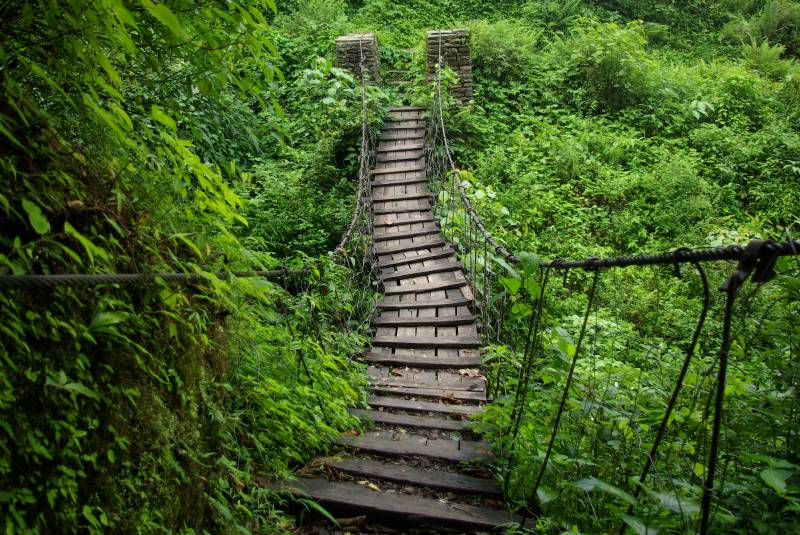
Broken bridge near Landruk.

Plowing rice fields near Landruk.
Day 9 was eventful, we hiked down to cross a river at 1300m before climbing up towards the village Landruk – there were even more leeches here than on the way to the hotsprings. I counted 5 on my boot at the same time, all slowly making their way up. A few got through undetected, I found one mark uncomfortably high up on my leg when showering later in the evening.. And speaking of shower I got showered in mud when we passed a terraced rice field where some farmers we plowing with oxes – the beasts made a burst through the flooded field just as I passed on the field below and I got completely soaked. Pretty sure the farmers did it on purpose..anyhow they found it incredibly funny. When Edel passed by they threw mud into the water to try and splash her also..but they didn’t do anything when Shiva/Deepak passed. You don’t mess with the mountain man! Everyone else in the villages we passed before Landruk (where I could clean up a bit) also found it incredibly funny. I took some photos of the farmers when they were plowing after, figured they owed me that much.. 😀
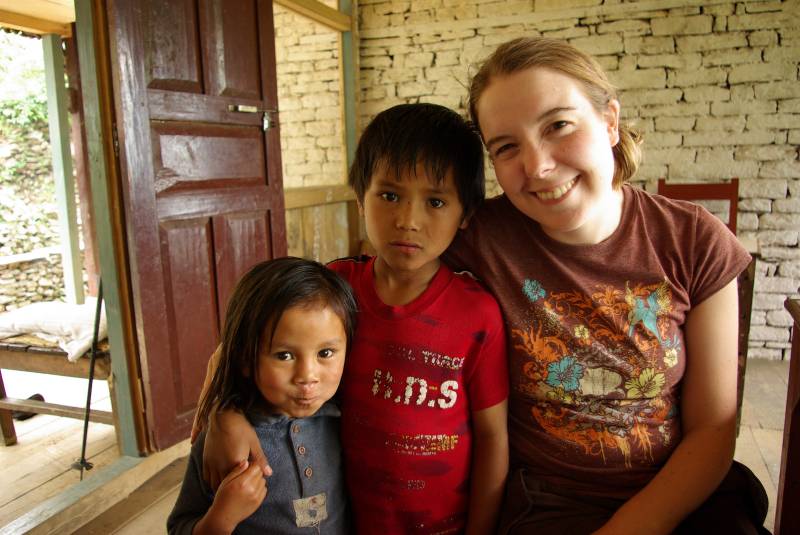
Edel with some more friendly locals.
On the way up to Deorali at 2200m the landscape again changed to forest, and we got a proper soaking in the afternoon in the pre-monsoon rains. The monsoon is late this year, and we were probably lucky to have escaped the rains so far – only one morning left of the trek where we’d need to put the wet boots on. We trekked on to Pothana in the rain where we spent the last night and had our last mountain dahl bhat. Played cards with Shiva and Deepak in the evening celebrating our last day of the trek. We spent another three days back in Pokhara, enjoying the comforts of civilization again. It would have been too easy to stay longer at our cozy guesthouse, but as the resident western stoner (who otherwise seemed a nice person) explained us the beneficial medicinal properties of drinking cow urine as an ayurvedic treatment..we felt it was probably time to move and booked a bus to Chitwan national park.
[if anyone comes across this page googling for Nepal trekking here is the email address and website of a great guide in the Annapurna/Pokhara region: Shiva; sbishwokarma@gmail.com / http://www.shivatrekkingnepal.com/]
